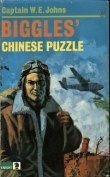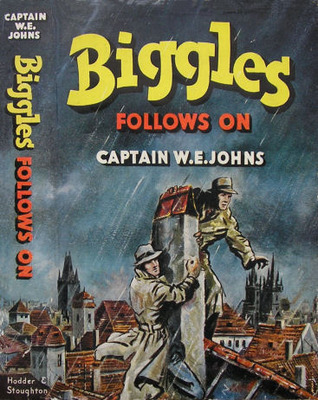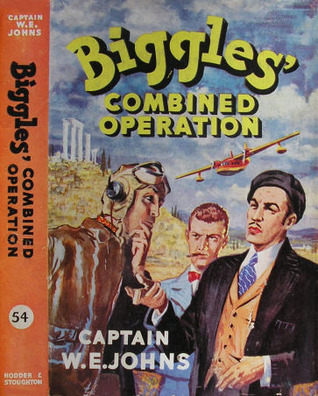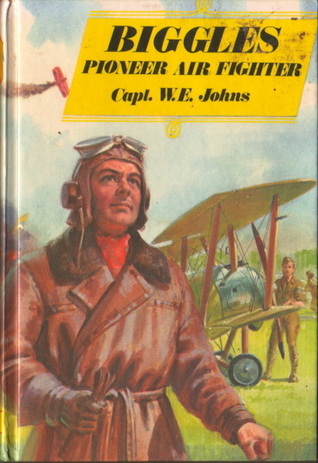
Part of Series
This contains thirteen short stories, eleven of which were originally published in "The Camels are Coming" (1932) and two (The Thought Reader and Biggles Finds His Feet) which were originally published in "Biggles of the Camel Squadron" (1934). The stories are: THE CARRIER Biggles' propeller kills a carrier pigeon but Biggles finds the message and goes to rescue a spy. SPADS AND SPANDAUS Biggles and his squadron join up with some Americans for a major air battle with the Germans. THE ZONE CALL A captured German pilot tricks Biggles, but he realises in time to foil a German attack. THE DECOY When Biggles loses one of his pilots to a German trick he goes all out to get the plane responsible. THE BOOB Biggles first meets a new pilot who happens to be his cousin and whose Christian name is Algernon. THE BATTLE OF FLOWERS Algy takes revenge when a German raid on the Squadron's aerodrome destroys his garden. THE THOUGHT-READER Biggles discovers a German plane receiving secret signals from a spy using corn in a field. BIGGLES FINDS HIS FEET Engine trouble forces Biggles down in 'no-man's-land' where he has a taste of trench warfare. THE BOMBER Biggles attacks a heavily defended new German bomber and has to devise a way to shoot it down. ON LEAVE Biggles is forced to take leave but manages to shoot down 2 German seaplanes that bomb the UK. FOG! Biggles gets lost in fog and is shocked to discover he has landed by a German gas supply dump. AFFAIRE DE COEUR Biggles meets the love of his life, Marie Janis, only to discover that she is a spy. THE LAST SHOW Biggles gets promoted to Major and is shot down only to discover the armistice has been signed.
Author
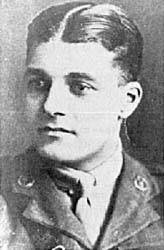
Invariably known as Captain W.E. Johns, William Earl Johns was born in Bengeo, Hertfordshire, England. He was the son of Richard Eastman Johns, a tailor, and Elizabeth Johns (née Earl), the daughter of a master butcher. He had a younger brother, Russell Ernest Johns, who was born on 24 October 1895. He went to Hertford Grammar School where he was no great scholar but he did develop into a crack shot with a rifle. This fired his early ambition to be a soldier. He also attended evening classes at the local art school. In the summer of 1907 he was apprenticed to a county municipal surveyor where he remained for four years and then in 1912 he became a sanitary inspector in Swaffham, Norfolk. Soon after taking up this appointment, his father died of tuberculosis at the age of 47. On 6 October 1914 he married Maude Penelope Hunt (1882–1961), the daughter of the Reverend John Hunt, the vicar at Little Dunham in Norfolk. The couple had one son, William Earl Carmichael Johns, who was born in March 1916. With war looming he joined the Territorial Army as a Private in the King's Own Royal Regiment (Norfolk Yeomanry), a cavalry regiment. In August 1914 his regiment was mobilised and was in training and on home defence duties until September 1915 when they received embarkation orders for duty overseas. He fought at Gallipoli and in the Suez Canal area and, after moving to the Machine gun Corps, he took part in the spring offensive in Salonika in April 1917. He contracted malaria and whilst in hospital he put in for a transfer to the Royal Flying Corps and on 26 September 1917, he was given a temporary commission as a Second Lieutenant and posted back to England to learn to fly, which he did at No. 1 School of Aeronautics at Reading, where he was taught by a Captain Ashton. He was posted to No. 25 Flying Training School at Thetford where he had a charmed existence, once writing off three planes in three days. He moved to Yorkshire and was then posted to France and while on a bombing raid to Mannheim his plane was shot down and he was wounded. Captured by the Germans, he later escaped before being reincarcerated where he remained until the war ended.
